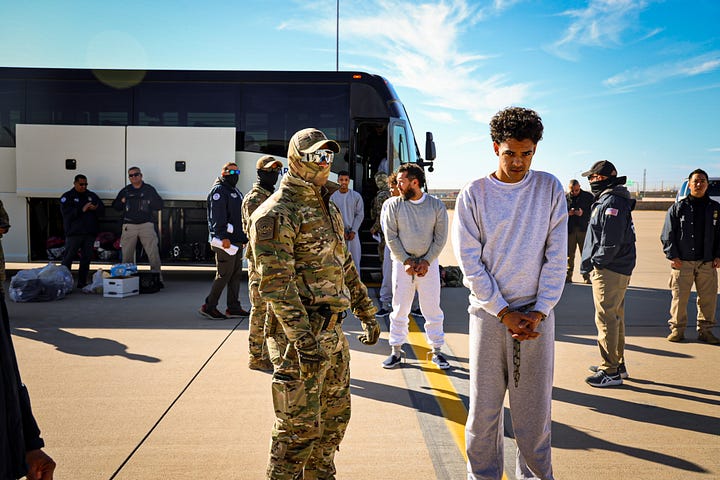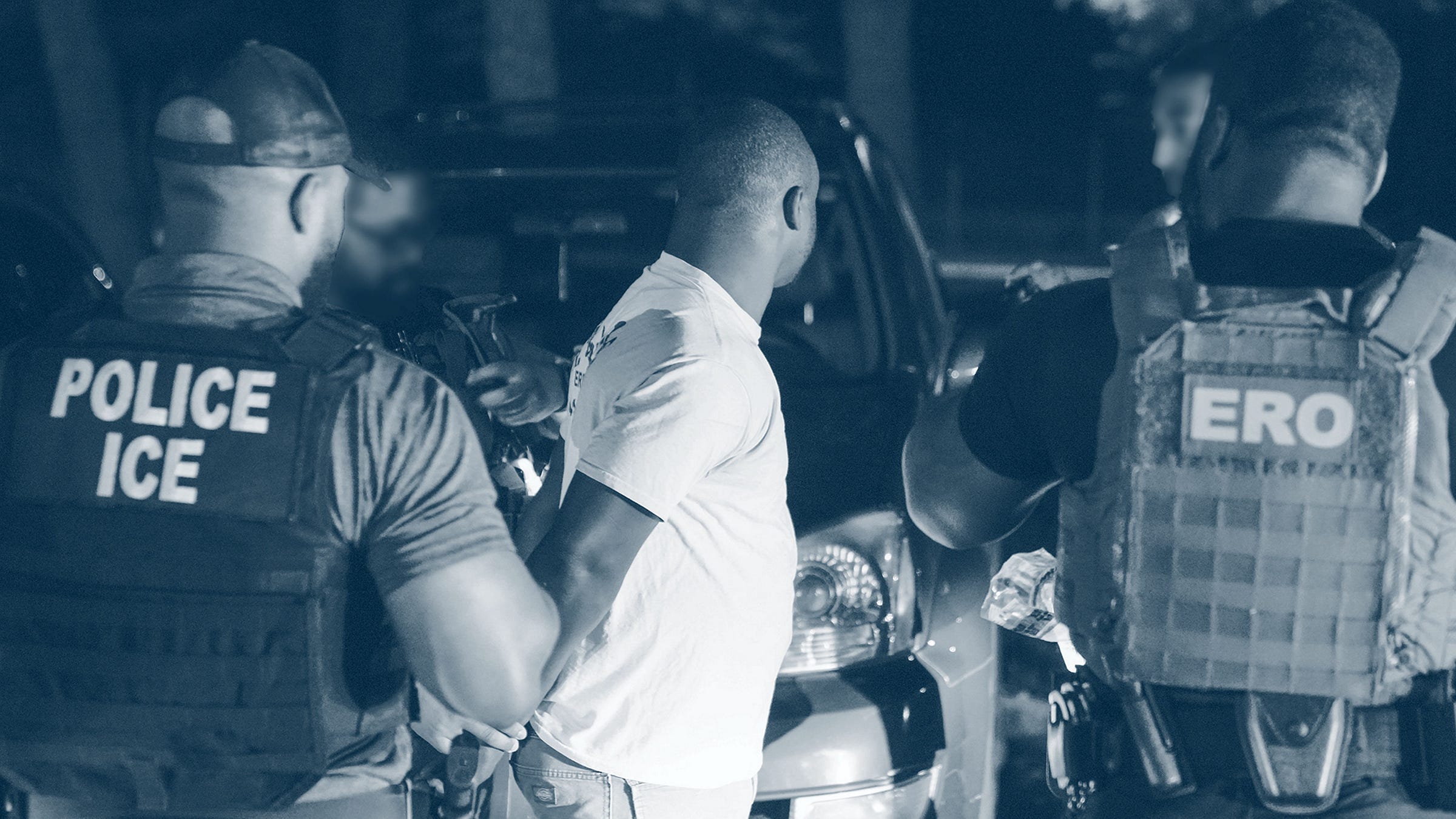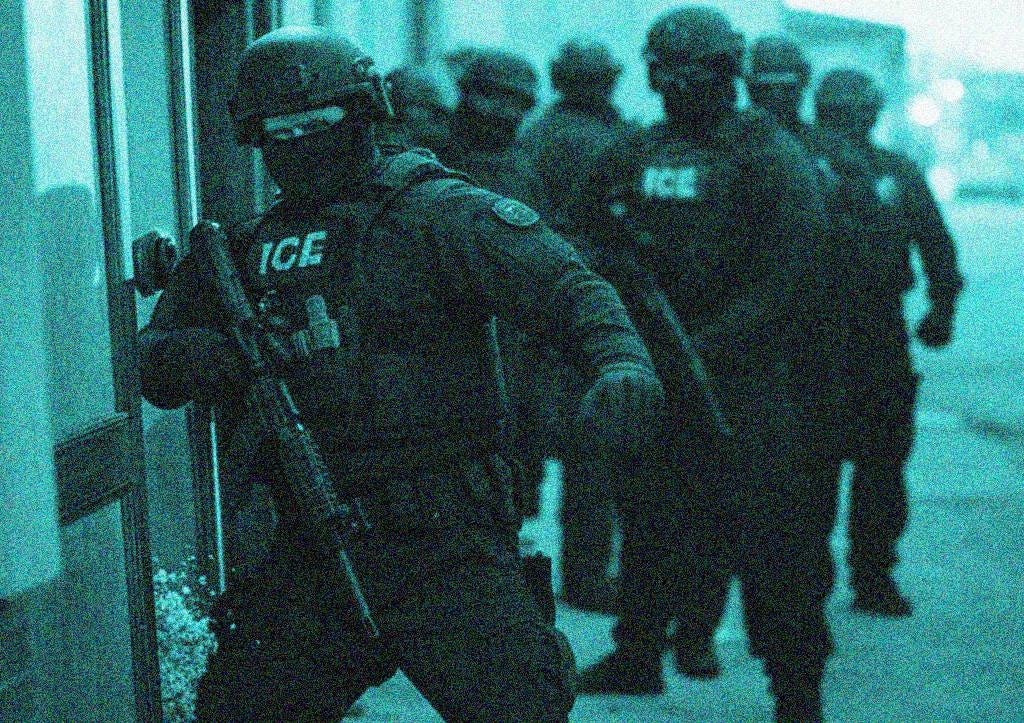ICE, Guantanamo Bay and the "low-hanging fruit" of Trump's mass deportation plans
More than 100 Venezuelans, most of whom have been convicted of no crime sent to infamous Caribbean detention center
As I write these words, a little more than 100 migrants, mostly Venezuelans, have been flown from the United States to one of the world’s most infamous prisons, Guantanamo, tucked into a bay on the Island of Cuba.
The prison, created in 2002 to house those detained without any due process as part of the “War on Terror”, has been described by the men who designed it as “the legal equivalent of outer space”, and has been criticized by human and civil rights groups alike for decades. The U.N. has said it is a site of "unparalleled notoriety", and that those who run it commit “unrelenting human rights violations.”
It was created as an alternative to “black sites” during the presidency of George W. Bush to deny anyone held there any of the protections that the U.S. Constitution grants to anyone who stands on its soil.
The facility consists of multiple “camps”, as described by the guards and officials who run the facility, though the word is employed broadly. The principal camp is a large, windowless concrete building, where, according to U.S Senate hearings, guards have tortured detainees by forcing them to stand for hours on broken limbs, engaged in waterboarding, sensory isolation, and forced inmates to stand in “stress positions” for long periods in search of intelligence.
By the time you read this, there are likely more than 100 migrant detainees being held in Guantanamo. Flights carry detainees almost daily from Fort Bliss, a sprawling military base in El Paso, Texas, to the feared prison facility. The administration’s declared goal is to hold 30,000 people at the base who would be otherwise difficult to deport.
“Guantanamo Bay will hold the worst of the worst,” tweeted Homeland Security Secretary Kristi Noem on February 4.
No evidence, few criminal records
The migrants, 53 of whom have been identified by the New York Times, are being held in “Camp 6,” the medium-security military facility once used to hold so-called “enemy combatants” captured as part of the U.S. “war on terror”. Sixty tent-like structures have also been erected, surrounded by razorwire: presumably to house new arrivals once the principal camp is at capacity.
Of the migrants who have so far been identified, all are men. The vast majority have not been convicted of any crime on U.S. soil, although some were moved from detention centers or holding cells after being accused of crimes by police.
Department of Homeland Security officials, and Trump, have claimed that many are part of the Venezuelan gang “Tren de Aragua”, though any evidence supporting those claims has not been made public, nor seen the inside of a courtroom.
Family members of some of those who have been identified, and contacted by U.S. journalists, have insisted that their loved ones have committed no crimes, and that supposed evidence suggesting gang affiliations is circumstantial at best.
Multiple family members contacted by the website Migrant Insider, have said detainees have often been in migrant detention centers for months, such as 25-year-old Yoiker David Sequera, a Venezuelan barber who was reportedly picked up by border agents in September after crossing the Darien Gap to reach the US. “My son is no criminal,” said one relative, who suspected Sequera had been targeted because of his tattoos.
The government claims that Sequera has a crown tattoo on his neck, and a Nike swoosh on his chest— evidence they claim proves he is part of the Tren de Aragua. I am not clear that either symbol is associated at all with the Tren de Aragua. And even if they were somehow, that would be tenuous evidence at best.
Detainees are held without communication from family members or migration attorneys, according to the ACLU, which has filed a lawsuit against the federal government on behalf of detained family members. Many of them had no idea where their loved ones had been taken until the Department of Homeland Security (DHS) released photos of handcuffed prisoners being taken aboard planes at Fort Bliss as part of a recent press release.


“The government has withheld information” regarding prisoners' legal proceedings, rights, migration status, and condition, said the ACLU in the lawsuit, citing the removal of foreign nationals for detainment at Guantanamo as “unprecedented”. The suit alleges that “this isolation is no coincidence,” and accuses the U.S. government of violating the legal rights of detainees by preventing them from communicating with legal counsel.
The administration says the migrants will be held at Guantánamo temporarily, until it can find other countries to take them, but plans to transfer them would face significant legal and logistical challenges.
Not the first time migrants have been held at Guantanamo

Former US President Joe Biden promised to close the facility but instead expanded some aspects of it. Migrants have been held at Guantanamo before, most notably between 2002 and 2006, when thousands of Haitians fleeing the island were stopped at sea and sent to Guantanamo to deter asylum claims.
President Obama also detained migrants at the Carribean detention facility, though in lesser numbers.
But the removal of foreign nationals from U.S. soil who have been convicted of no crimes to Guantanamo is unprecedented.
The Trump administration has also raised the idea of sending detainees to El Salvador, an idea that El Salvadoran President Nayib Bukele has expressed strong support for. But such a plan would likely face even steeper legal hurdles than sending migrants to Guantanamo.
Trump is reportedly irate about the slow rate of detentions
“It’s driving [Trump] nuts they’re not deporting more people,” one administration official told NBC News. “The numbers are too fucking low!” Trump is telling his aides, another source told NewsNation. DHS deportation numbers under Trump may be lagging behind Biden. Trump’s team stopped giving daily detention number updates in early February, perhaps exactly because of that reason.
Another source familiar with internal conversations at ICE said “Border Czar” Tom Homan has a daily conference call with ICE agents in which he has been known to express his frustration with detention numbers, exerting pressure on agents to raise them.
WOLA reports that as ICE detention facilities are at capacity, the administration has begun using federal prisons in Los Angeles, Miami, Philadelphia, Atlanta, Leavenworth, Kansas, and Berlin, New Hampshire as migrant detention facilities.
In addition to the lack of sufficient concentration camps to hold detainees, another bottleneck may be a drop in migrant flows across the Americas generally. The Darien Gap, which when PWS visited in June 2024 was experiencing more than a thousand crossings daily, is currently reporting daily numbers lower than 100.
A similar phenomenon happened at the beginning of Trump’s last presidency as migrants and smuggling networks took a “wait and see” approach to how Trump’s hardline rhetoric would play out in reality. The numbers skyrocketed a few months later as migration flows adapted to the changing situation.
Trump, for the moment, seems to have popular support for his mass detention policy. A CBS News / YouGov poll found 59 percent of U.S. respondents approve of “the Trump administration’s program to deport immigrants illegally in the United States,” 64 percent in favor of “sending U.S. troops to the U.S.-Mexico border,” and 48 percent even in favor of “large detention centers while determining who should be deported.” Fifty-three percent of respondents in the February 5–7 survey said they approved of Donald Trump’s overall performance, one of the highest measures Trump has ever received.
But as the Trump administration runs out of “low-hanging fruit” regarding detentions and deportations with border arrivals, they may look to other sources, a dynamic that puts vulnerable communities at considerable risk.
With pressure rising to get numbers up, and border arrivals at a 5-year low, the U.S. is likely to turn its xenophobic police state inwards on its own population. In order to fulfill Trump’s Inauguration Day promise of “millions and millions” of deportations, the Trump administration would have to deport over 2,700 immigrants every day to reach 1 million in a year.
Homan himself has said ICE will be focusing on raids in large cities to fill the gap. But as Colombia knows from its own history all too well, when pressure is on field operatives to get numbers up, they often turn to defenseless and innocent people as the easiest targets.
At PWS we hope that “False Positives” is something the U.S. never has to experience. But we fear that under current dynamics, that may be the direction we’re heading in.
The Big Headlines in LATAM
Argentina’s President Javier Milei’s backing of the crypto token $Libra that collapsed in hours is a story that the administration is hastily trying to rewrite amid calls for impeachment and international media attention.
On Friday night, the president took to X announcing the “Viva la Libertad Project” and promoting a token called $Libra, claiming it would bolster Argentina’s economy. The token’s value soared and promptly plummeted within hours in what is known as a “rug pull,” with eight users making away with most of the US$4.5 billion market cap.
The backlash was immediate and multipartisan. You can read more about this crazy story at the Buenos Aires Herald.
In a biblical story from Chile, a kayaker was swallowed whole by a whale. before being spit back out unharmed. “I thought I was dead,” he told Al Jazeera. You can watch the video of the episode here.
The first round in Ecuador’s elections were much closer than polls predicted, with a statistical tie between right-wing Daniel Naboa and his left-leaning rival Luisa Gonzales.
Naboa has since tried to cast doubt on election results, claiming without proof that his team has discovered “irregularities” in the process. Election observers from both the U.N. and other Latin American countries have rejected his assertions.
Spanish Word of the Week
armar la gorda! - literal translation: “arm the fat lady”
In Argentina, “arming the fat lady” is synonymous with “arming the revolution”, a revolt, or an armed uprising against power. “La Gorda” was the name given in Seville to the revolution that was brewing in September 1868 against Queen Isabel II in Spain, with General Prim as the leader of the anti-Isabelian movement.
Colloquially it can also mean “some shit is coming” more broadly, outside of the context of revolution. But at PWS we like the original meaning.
In his autobiographical book The Life and Times Don Nobody (1929), writer Luis Montoto says that between the months of July and September 1868 the whiff of revolt could already be smelled in the air and that the Sevillians in particular were already waiting for La Gorda.
“Esperábamos a La Gorda. En cafés y tabernas, en las plazas y en las calles, sin miedo a la policía, se preguntaba: ¿Cuándo se va a armar?…”
“We were waiting for La Gorda. In cafes and taverns, in the squares and in the streets, without fear of the police, the question was asked: When is she going to arm herself?...”
Pero cuando se va a armar la gorda en contra de estos HdP’s de ICE?
We’ll let you translate that last phrase on your own. haha. Hasta pronto, piratas!





